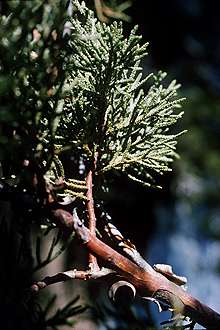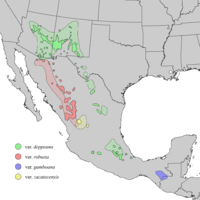Juniperus deppeana
Juniperus deppeana (alligator juniper or checkerbark juniper; Native American names include táscate and tláscal) is a small to medium-sized tree reaching 10–15 m (rarely to 25 m) tall. It is native to central and northern Mexico (from Oaxaca northward) and the southwestern United States (Arizona, New Mexico, western Texas). It grows at moderate altitudes of 750–2,700 meters (2,460–8,860 ft) on dry soils.
_in_the_Magdalena_Mountains%2C_New_Mexico.jpg)
| Juniperus deppeana | |
|---|---|
 | |
| Scientific classification | |
| Kingdom: | Plantae |
| Clade: | Tracheophytes |
| Division: | Pinophyta |
| Class: | Pinopsida |
| Order: | Pinales |
| Family: | Cupressaceae |
| Genus: | Juniperus |
| Species: | J. deppeana |
| Binomial name | |
| Juniperus deppeana | |
 | |
| Natural range of Juniperus deppeana | |
The bark is usually very distinctive, unlike other junipers, hard, dark gray-brown, cracked into small square plates superficially resembling alligator skin; it is however sometimes like other junipers, with stringy vertical fissuring. The shoots are 1-1.5 mm diameter; the leaves are arranged in opposite decussate pairs or whorls of three; the adult leaves are scale-like, 1-2.5 mm long (to 5 mm on lead shoots) and 1-1.5 mm broad. The juvenile leaves (on young seedlings only) are needle-like, 5–10 mm long. The cones are berry-like, 7–15 mm in diameter, green maturing orange-brown with a whitish waxy bloom, and contain 2–6 seeds; they are mature in about 18 months, and are eaten by birds and mammals.[1] The male cones are 4–6 mm long, and shed their pollen in spring. It is largely dioecious, producing cones of only one sex on each tree, but occasional trees are monoecious.
There are five varieties, not accepted as distinct by all authorities:
- Juniperus deppeana var. deppeana. Throughout the range of the species. Foliage dull gray-green with a transparent or yellowish resin spot on each leaf; cones 7–12 mm diameter.
- Juniperus deppeana var. pachyphlaea (syn. J. pachyphlaea). Arizona, New Mexico, northernmost Mexico. Foliage strongly glaucous with a white resin spot on each leaf; cones 7–12 mm diameter.
- Juniperus deppeana var. robusta (syn. J. deppeana var. patoniana). Northwestern Mexico. Cones larger, 10–15 mm diameter.
- Juniperus deppeana var. sperryi. Western Texas, very rare. Bark furrowed, not square-cracked, branchlets pendulous; possibly a hybrid with Juniperus flaccida.
- Juniperus deppeana var. zacatecensis. Zacatecas. Cones large, 10–15 mm diameter.
Uses
The berrylike cones are eaten by birds and mammals.[2]
References and external links
| Wikimedia Commons has media related to Juniperus deppeana. |
- Adams, R. P. (2004). Junipers of the World: The genus Juniperus. Trafford Publishing ISBN 1-4120-4250-X
- Gymnosperm Database: Juniperus deppeana
- Flora of North America: Juniperus deppeana
- USDA Plant Profile: Juniperus deppeana
- Conifer Specialist Group (1998). "Juniperus deppeana". IUCN Red List of Threatened Species. 1998. Retrieved 28 July 2006.CS1 maint: ref=harv (link)
Specific
- Little, Elbert L. (1994) [1980]. The Audubon Society Field Guide to North American Trees: Western Region (Chanticleer Press ed.). Knopf. p. 313. ISBN 0394507614.
- Whitney, Stephen (1985). Western Forests (The Audubon Society Nature Guides). New York: Knopf. p. 370. ISBN 0-394-73127-1.
